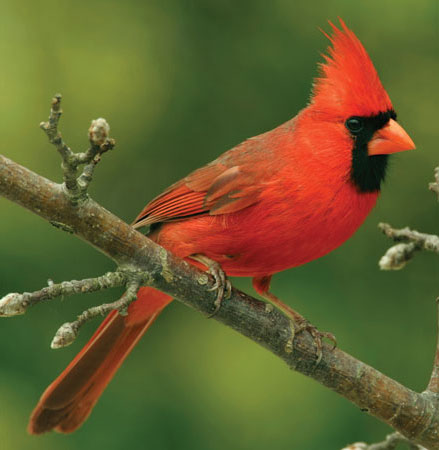Cardinalis cardinalis
What’s not to love about about a cardinal perched on a branch in your yard? With its stunning color, conspicuous crest, and lovely song, the Northern Cardinal is a very popular feeder visitor. No less than seven states have made this beautiful bird their state bird (IL, IN, KY, NC, OH, VA, WV). Cardinals can be found in all of the states east of the Mississippi River.
Northern Cardinals are year-round residents within their range. And they have been expanding their range northward since the 1800’s. This expansion has been attributed to warming climate, increasing availability of their preferred habitat, and the increase in food sources with the growing popularity of birdfeeding. They are found in areas with shrubs and small trees, including backyards, forest edges, overgrown grassy fields, and hedgerows.
Northern Cardinals are food generalists, consuming seeds, fruits, and insects. The source of the bright red color of the male is carotenoids in their diet, something found in insects and fruits, but not in seeds. Average annual consumption is 70% plant sources and 30% insect, with their fledglings fed almost exclusively insects. During winter months the cardinal’s diet shifts to vegetable matter. They are frequent winter visitors at backyard birdfeeders. The large, conical bill of the Northern Cardinal is ideal for cracking their favorite feeder offerings, sunflower and safflower seeds.
Cardinals are not gregarious and most often are seen in family units rather than flocks. They remain in a local area for most of their lives. Couples are monogamous and a typical clutch size is 2-3 eggs. During courtship the females will often beg for food like a juvenile. Males are responsible for most of the feeding of the fledglings.
Unlike many songbird species in which only the male sings, both male and female cardinals sing. And why not when your repetoire is a beautiful as a cardinal’s? The melodic, slurred whistles of the cardinal are described as: “what cheer, what cheer!” and “Purdy, purdy, purdy.”
As you watch the Cardinals in your yard, try identifying them by age and sex. It really is quite easy to do. The males are brilliant red with a black mask and red bill. Females are a greyish tan with soft, red hues and the same bright red bill of the male. First year birds look like Mom, but have a dull brown bill. Enjoy the challenge, but don’t overlook the sheer beauty of the sight and sounds of the Northern Cardinal!
Reference
Halkin, Sylvia L. and Susan U. Linville. 1999. Northern Cardinal (Cardinalis cardinalis), The Birds of North America Online (A. Poole, Ed.). Ithaca: Cornell Lab of Ornithology.

